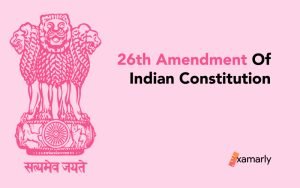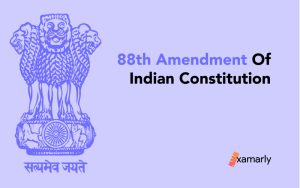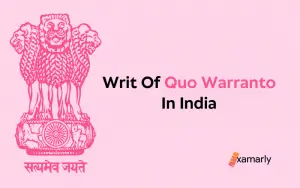According to the 36th Amendment Of Indian Constitution, Sikkim was added as the 22nd state of the Indian union with a majority voting in favor of the decision. The Sikkim Provincial Legislature was to be created as a consequence of the Sikkim elections, and this legislation mandates that the Sikkim Legislative Council must have at least 32 members. In accordance with the Constitution, the 32 Members who were duly elected during the elections conducted in April 1974 were recognized as comprising the legislative assembly of Sikkim state.
- Historical perspective of the 36th Amendment Of Indian Constitution
- Salient Features Of The 36th Amendment Of Indian Constitution
- Responsibilities Of The Indian Union
- Representation Of The Sikkim People
- The Aftermath Of 36th Amendment Of Indian Constitution
- Special Provisions Relating To Sikkim
- Conclusion
Historical perspective of the 36th Amendment Of Indian Constitution
- Sikkim lies in our country’s northeast part. It is surrounded by Nepal, Bhutan, and Tibet. A small hereditary monarchy previously controlled this Himalayan nation for almost three centuries beginning in the 17th century.
- In 1890, according to Anglo-Chinese Treaty, Sikkim was made a British dominion.
- The kingdom was given autonomy over its internal affairs in 1950, and it maintained its status as a “Protector State” within the Union of India.
- Chogyal ( the ruling monarch) called for a referendum in September 1974. In a subsequent referendum, up to 97.5% (59,637) of the participants voted in the majority in favor of joining India. while only 2.45% (1,496) voted against the motion. But, the monarch was not happy with the outcome of this referendum.
- On March 5, 1975, the Chogyal once more demanded a referendum while the National Congress reiterated its aspirations for unification into India.
- On April 9, 1975 , Indian troops invaded the nation, overpowered the guardsmen (killing one of them and injuring four others), and besieged the palace. The king was placed under house arrest.
- The Legislative assembly of the state of Sikkim unanimously passed a resolution on April 10, 1975. pointing out Chogyal’s continued harmful activities and the undermining of the government, Sikkim Act, 1974. The resolution stated that these activities by Chogyal not only violated the objectives of May 8, 1973, Agreement but also went against the wishes of the people of Sikkim and hindered their democratic development and participation in political and economic activities.
- On April 14, a referendum on this matter was conducted. On April 15, 1975 Sikkim’s Chief Minister informed the Indian government of the poll’s findings. The Chief Minister implored to the Indian Government on behalf of the Council of Ministers to respond immediately, accept the aforementioned decision, and take whatever steps may be necessary and appropriate to implement the decision as soon as possible.
- On April 16–17 of that year, the Chief Minister of Sikkim and his council of ministers travelled to New Delhi to press the Indian Parliament to act right away. After due discussion in the Parliament, the green nod was given for the merger of Sikkim in the Union of India.
- On May 15, 1975, the then-President of India, Fakhruddin Ali Ahmed, authorized a constitutional modification. On the next day, it resulted in the dissolution of Chogyal’s status and the creation of Sikkim as the 22nd state of India.
Salient Features Of The 36th Amendment Of Indian Constitution
- Amendment of First Schedule and adding Sikkim after entry 21 under the title “I. THE STATES” in the First Schedule of the Constitution.
- A new article 371F, after article 371E, was added to the Constitution, with important requirements pertaining to the State of Sikkim.
- Elimination of 10th schedule.
- 4th and 10th schedules were altered along with Sections 80 and 81, under Section 368.
Related – 91st Amendment Of Indian Constitution
Responsibilities Of The Indian Union
The duties of the Government of India were to:
- The Governor of Sikkim was granted special responsibility for peaceful and just settlements in order to promote the social and economic development of various sectors of the people of Sikkim and discharges his special responsibilities under this section.
- The Governor of Sikkim is free to make decisions at their sole discretion and to adhere to any instructions that the President may occasionally find suitable.
- Prior to the given date, all property and property possessed by the Government of Sikkim and/or any other agency or person for the purposes of the Government of Sikkim must be surrendered to the State Government (whether inside or outside Sikkim).
- After the appointed date, the Sikkim High Court shall be deemed to be the High Court acting in the territory of Sikkim. All agencies and all legal, executive, and governmental personnel, as well as all courts with civil, criminal, and revenue jurisdictions, must continue to carry out their respective duties on and from the designated day, pursuant to the requirements of this Constitution.
- The President was given authority to, make any amendment necessary or appropriate to any law, whether repealing or amending the law, to facilitate the application of existing law in relation to the administration of Sikkim.
- The President was to be asked questions on the exclusion of delegates, and he/she was to make a decision on the matter after due consultation with the Election Commission.
- Disputes or other disputes arising out of treaties, agreements, obligations or other similar instruments relating to Sikkim made or executed before the date specified, to which the Government of India or any of its predecessor governments were parties; Subjected to the jurisdiction in respect to the Supreme Court or any other courts jurisdiction. Nothing in this Section shall be construed to deviate from the provisions of Section 143.
- If any of the aforementioned elements of this article are difficult to enforce, the President may take whatever steps he considers necessary to resolve the issue (including adjusting or amending other provisions)
Representation Of The Sikkim People
The Ordinance also included the Sikkim people’s participation in the Parliament and other democratic processes. It had the following phrases in it :
- In both, the houses of the Indian Parliament (Lok Sabha and the Raj Sabha) citizens were given representation opportunities with 1 seat in each of them.
- The Lok Sabha delegate for the state was chosen by the common people, while the Rajya Sabha delegate was chosen by the Assembly. Sikkim was to be treated as a single district connected with parliament.
- The criteria for becoming a member of the Assembly and a member of Parliament were the same.
- The delegates to the Lok Sabha and Rajya Sabha were regarded as members of the respective houses of the parliament.
- Members of the Legislative Assembly of the state of Sikkim elect a State Representative to take office in the People’s Assembly on a specified date. In order to protect the rights and interests of the electors of those sections, the Assembly may make provisions regarding the number of seats in the Legislative Assembly of the state of Sikkim to be filled by the candidates of that section.
- New Article 371F was added to the Constitution after Article 371E, Under this article – The Legislative Assembly of the State of Sikkim was to be composed of at least thirty members.
- References to the period of five years in clause 1 of article 172 shall be construed as references to a period of four years in the case of the Assembly determined to be the Legislative Assembly of the State of Sikkim under this clause.
The Aftermath Of 36th Amendment Of Indian Constitution
By virtue of the Constitution 36th Amendment Act of 1975 and the unique provisions established for the State under article 371(F) of the Constitution of India. The monarchy was dissolved on May 16, 1975, when Sikkim was admitted as the 22nd state of the Indian Union. The Indian Parliament modified the Indian Constitution to allow for the formation of the new state.
Special Provisions Relating To Sikkim
The 36th Amendment also inserted 371F- after article 371E, which provides for certain special provisions concerning the state and those are as given below :
- The Legislative Assembly of the state consists of a minimum of 30 members and has the same powers and functions as those of a State Legislative Assembly provided under the Indian Constitution.
- The amendment also gave the Parliament the authority to establish rules for the Legislative Assembly of the state of Sikkim for elections of residents from various sectors of the state.
- The Sikkim Governor was in charge of maintaining order as well as the social and economic progress of the various segments of the Sikkim population.
- Sikkim’s laws were amended or repealed by the President to bring them into compliance with the Indian Constitution before the amendment. No court has the jurisdiction to review such a decision of the President. It had been stipulated that the President’s authority would expire after two years.
Conclusion
Association of Sikkim was done by including it in the First Schedule of the Constitution as a full-fledged State of the Indian union. One representation was granted in the State Assembly and one member in the Parliament. It was also suggested to create a new article with the provisions thought necessary to suit the special requirements and conditions of the state.






